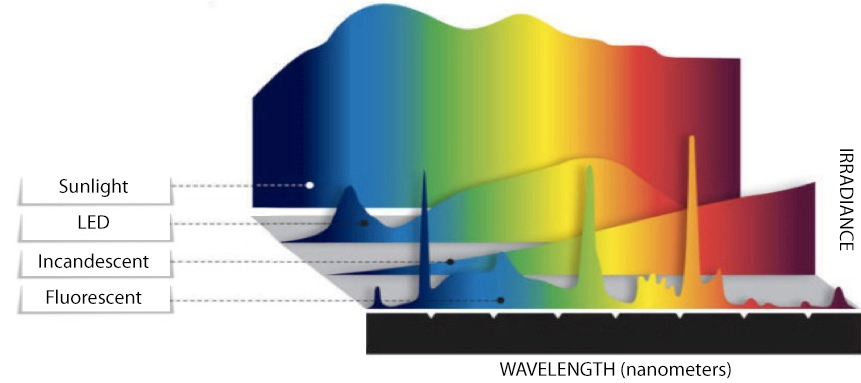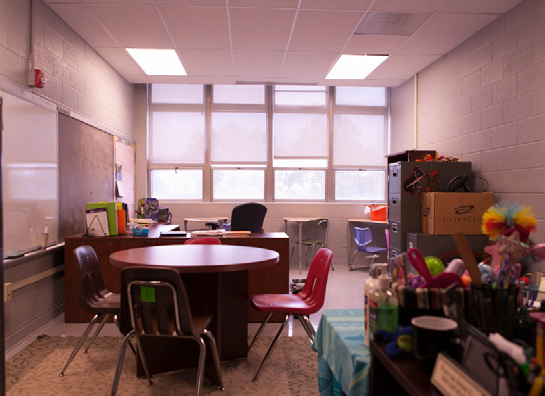Improving Health, Safety and Performance in Classrooms with a Simple Switch
Current State of Classroom Lighting
For over a century, fluorescent bulbs have been the groundbreaking technology in lighting. Since the 1940s, we have been educated under fluorescent lights in schools, worked under them in offices, exercised under them in gymnasiums, and treated under them in hospitals. With the advent of the compact fluorescent bulb, we even brought them into our homes.
Fluorescent lights are gas-filled tubes with a phosphorescent coating on the inner surface. Electrical current is passed through a voltageregulating ballast to a tungsten-coiled electrode. When the lights are turned on, a voltage “kick” from the ballast instantly (or, in older technologies, more gradually) vaporizes small amounts of mercury within the tube, causing them to emit ultraviolet (UV) light. The inner surface coating absorbs the UV light and converts it to visible light, producing a ‘white-ish’ glow.
With lighting a necessity in our lives, unfortunately fluorescent lights have become essential due to the lack of competitively priced technology with comparable light output and efficiency.
Current Impact of Fluorescent Lighting on Students
Mercury is a hazardous material. Fluorescent tubes contain a mixture of mercury and inert gases when current is running through them, and a broken fluorescent tube carries the risk of mercury entering the body through the lungs (via breathing in the gas) or the skin (from coming in contact with mercury residue on the inner glass surface). In the unforeseen event that a fluorescent light bulb shatters, anyone in the vicinity will be exposed to the dangers of mercury, making it a safety hazard in schools.
The mercury gas in fluorescent bulbs produces UV light, which is partially, but not completely, converted to light in the visible spectrum. Ultraviolet radiation operates at a higher frequency than visible light and is able to break bonds in many polymers, causing damage to materials such as plastics, as well as the tissues in our eyes and skin. Prolonged exposure can result in a clouding of the lens, commonly known as cataract formation, and is a contributing factor to age-related macular degeneration – the leading cause of blindness. Young people are especially at risk to the hazards of UV light, as a protective deposition of yellow pigments in the eyes occurs with age, attenuating the amount of radiation reaching the retina in older adults.
In addition to UV light, the visible radiation emitted by fluorescent light sources consists of three spikes (magenta, yellow-green, and orange), with minimal if any other wavelengths contributing to the output. The human visual system transmits those light signals to the brain, which must ‘fill in the gaps’ to process the picture. Students learning in poor-spectrum lighting environments often have a difficult time concentrating. Some people have extremely sensitive vision, particularly in the scotopic (low-lit) range, and low-spectrum lighting can trigger the same visual response. These individuals with scotopic sensitivity syndrome are commonly misdiagnosed with dyslexia or other learning disabilities, as well as being subjected to dizziness, headaches and nausea caused by the spikes and gaps in fluorescent light output.
The LED Lighting Technology Alternative
Light Emitting Diodes (LED) are a cutting-edge solid-state technology that are predicted by the US Department of Energy to replace almost all artificial lighting in the United States by 2030. While the basic technology has been available for years, recent developments have driven down cost and made LEDs more widely-available to the general public. Available as alternatives to everything from industrial and landscaping feature lighting, to residential settings, to the ubiquitous fluorescent tubes in schools and offices, LEDs provide a number of benefits over their predecessors. Known primarily for their energy efficiency, LED bulbs produce more lumens per watt, resulting in higher efficacy as less power is needed to produce the same or more light output. LEDs are also superior when it comes to quality of light output, as white tubular LED lamps provide the closest spectral match to sunlight (Graph 1), with no spikes or gaps in color output. And unlike their fluorescent counterparts, LEDs are 100% visually efficient; that is, they only produce radiation in the visible range, with virtually no harmful UV or wasted infrared.
Additionally, LED bulbs contain no mercury or hazardous waste, and are 100% recyclable. High-quality LED products can last up to 20x longer than any other artificial light source, reducing the time, cost, and effort of maintenance.8 These factors combine to make LEDs the clear choice over fluorescents.

Benefits of LED Lighting for Students
Good lighting aids cognition in many ways. This is especially important in the case of children and young adults.
Physical Utility
The smooth curve and constant irradiance across the full spectrum of visible wavelengths results in more saturated, vivid, discriminable color rendering and effortless visual acuity. Fully directional down-lighting also provides more illumination on working surfaces, rather than the diffuse glow produced by the gas-filled fluorescent tubes.
The correlated color temperature, color rendering, and luminous efficacy of LED lights combine to improve visibility to create a better learning environment. Vision is a contributing factor to an individual’s ability to attend and respond to classroom instruction.
Cognitive Utility Most parents encourage their children to get a good night’s sleep on a school night. A healthy sleep/wake cycle (or Circadian Rhythm) is crucial to mental cognition. Our bodies’ roughly 24-hour cycle is governed by hormonal responses that are triggered by full-spectrum light – light provided by sunlight and LED, but not fluorescent.9 When the light needed to trigger circadian responses is provided, alertness, attention and participation increase among students, as shown by a Case Western Reserve University study.10 Similarly, the US Army conducted a study with Tufts University showing that LED lighting resulted in increased productivity over fluorescent lighting.

Fluorescent
LED
We have all experienced the relief of leaving a fluorescent-lit classroom and stepping outside for recess on a sunny day. The spectral output of fluorescent lights is to blame. In the bleak winter months, many people are diagnosed with Seasonal Affective Disorder (SAD), while many more self-diagnose their yearly “winter blues.” LED lighting is used in the treatment of SAD, and also has been shown to improve mood, decrease stress, and create a generally healthier and happier environment – all because the lighting spectrum mimics that of natural sunlight.
Conclusion
LED lighting is the best choice for schools that want to foster a safe, healthy, comfortable, and “green” environment for their students and teachers. The benefits range from monetary savings – from electricity costs and less frequent bulb replacements – to increased teacher productivity, student participation and learning, and ocular safety. These lights best eliminate the lighting-related competing element in schools that physically directly affects the students’ vision and physiologically affects their ability to and capacity to learn. Just like the societal revolution, LEDs are no longer the future of the lighting industry. They are the present, and should be the source illuminating future generations.
Here is the origeal pdf from interactive-energies.
Any problem, please feel free to contact us, we will do best for you.